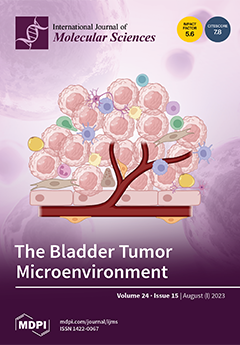Interstitial lung disease (ILD) constitutes the most critical comorbidity in autoimmune diseases (ADs) and its early diagnosis remains a challenge for clinicians. Accordingly, we evaluated whether E-selectin, ICAM-1, and ET-1, key molecules in endothelial damage, could be useful biomarkers for the detection of
[...] Read more.
Interstitial lung disease (ILD) constitutes the most critical comorbidity in autoimmune diseases (ADs) and its early diagnosis remains a challenge for clinicians. Accordingly, we evaluated whether E-selectin, ICAM-1, and ET-1, key molecules in endothelial damage, could be useful biomarkers for the detection of AD-ILD
+. We recruited patients with rheumatoid arthritis (RA)-ILD
+ (
n = 21) and systemic sclerosis (SSc)-ILD
+ (
n = 21). We included comparison groups of patients: RA-ILD
− (
n = 25), SSc-ILD
− (
n = 20), and idiopathic pulmonary fibrosis (IPF) (
n = 21). Serum levels of these proteins were determined by ELISA. E-selectin, ICAM-1, and ET-1 serum levels were increased in RA-ILD
+ and IPF patients in comparison to RA-ILD
− patients. Additionally, SSc-ILD
+ and IPF patients exhibited higher ICAM-1 levels than those with SSc-ILD
−. The ability of E-selectin, ICAM-1, and ET-1 to discriminate RA-ILD
+ from RA-ILD
− patients, and ICAM-1 to distinguish SSc-ILD
+ from SSc-ILD
− patients was confirmed using ROC curve analysis. Furthermore, elevated levels of ET-1 and E-selectin correlated with lung function decline in RA-ILD
+ and SSc-ILD
+ patients, respectively. In conclusion, our findings support the relevant role of E-selectin, ICAM-1, and ET-1 in RA-ILD
+ patients as well as of ICAM-1 in SSc-ILD
+ patients, constituting potential screening blood biomarkers of ILD in AD. Moreover, this study suggests ET-1 and E-selectin as possible indicators of worsening lung function in RA-ILD
+ and SSc-ILD
+ patients, respectively.
Full article






